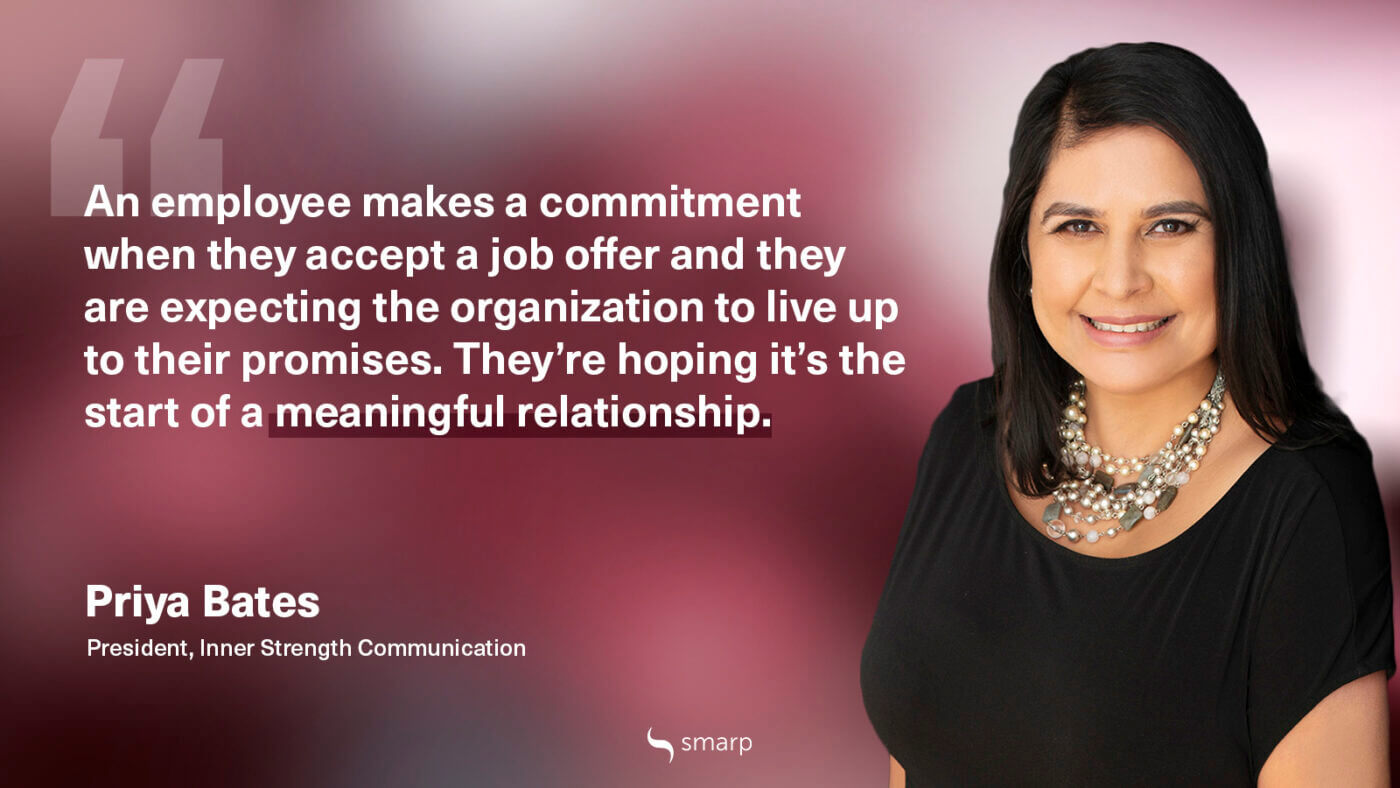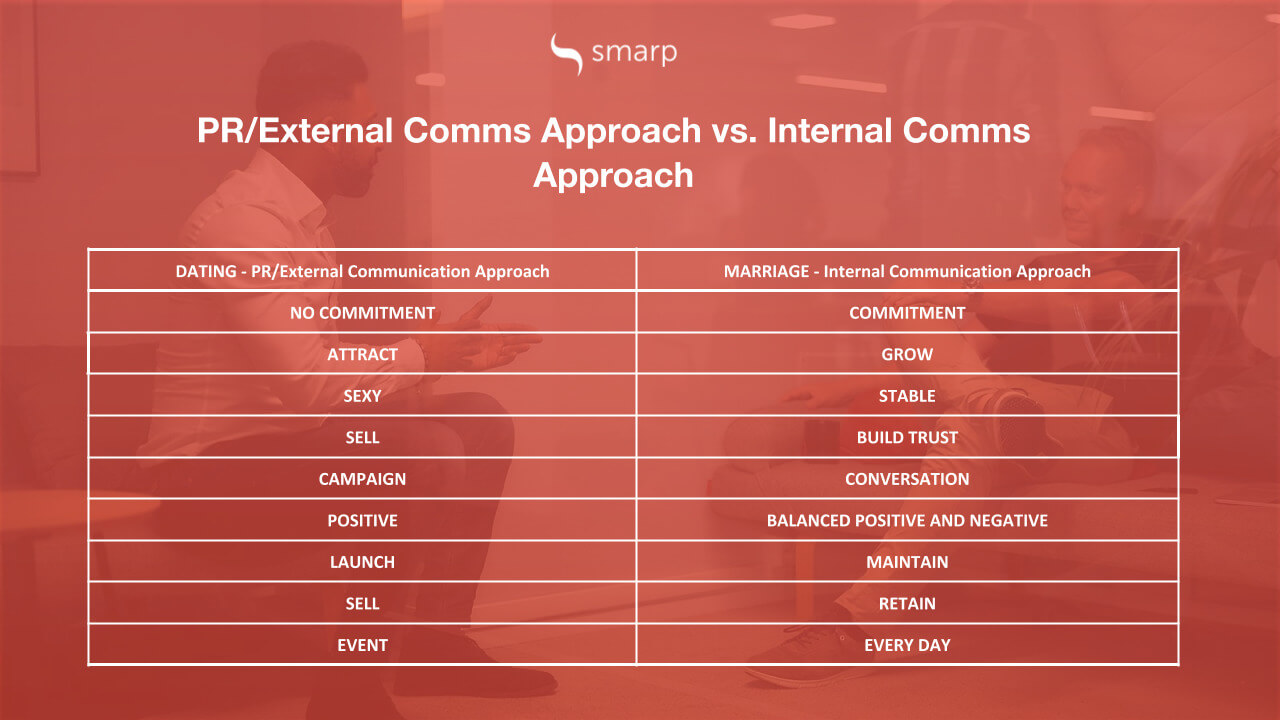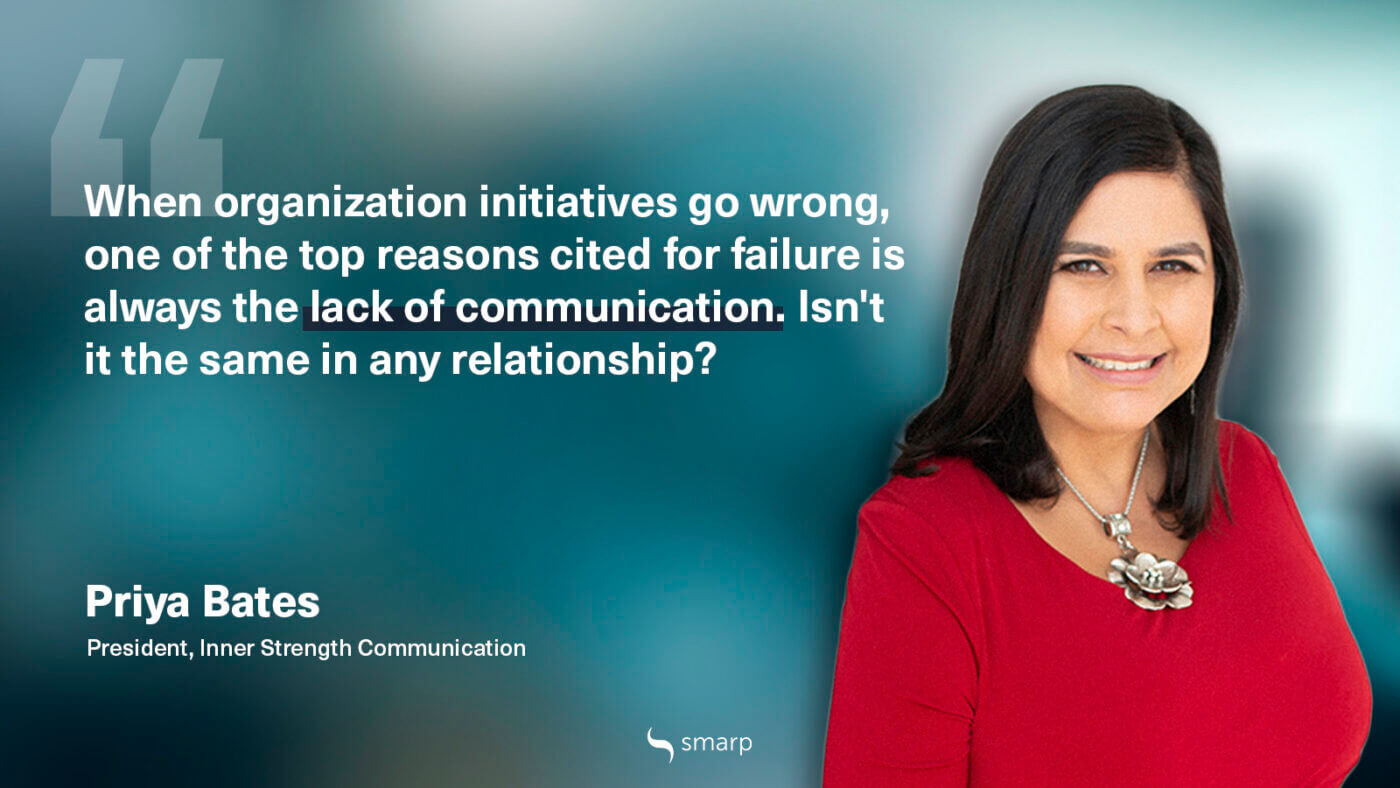Internal communication is the cornerstone of every business. It impacts employees’ understanding of the business, performance, satisfaction and engagement. But building great internal comms doesn’t happen overnight. It’s all about building trust and insightful conversations in the workplace. It requires time, commitment and two-way relationships.
We’ve asked Priya Bates, IC expert and President at Inner Strength Communication Inc. to tell us about the analogy she uses to describe internal communication — internal communication like a marriage. Here is what she had to say:
For 25 years, I have been trying to explain the difference between internal communication and external communications — like public relations (PR) and marketing. Are they simply the same processes and procedures with a different focus?
💡Download our eBook “Building a Better Company with Internal Communications” and learn how to take your internal communication to the next level!
When googling the question, “What is the difference between internal and external communications, “ what you get is a plethora of definitions that describe the who (audiences) and the what (process or vehicles) but very few articles talk about the why or the how in a way that demonstrates the equal importance of communicating to your internal audiences.
The analogy that I’ve started using recently, that seems to be resonating with communication professionals and leaders alike, is that PR and Marketing are what you do when you’re dating and Internal Communication is like communicating in a marriage.
Why Is It Important to Distinguish the Two?
Companies are starting to invest in Internal Communication.
In the past, internal communication was often seen as less important than external communication and marketing since the latter seemed to have more ROI attached. Internal communication was a stepping stone or simply added on to other responsibilities.
In most cases, the responsibility for internal communication was generally given to junior or inexperienced employees. How many HR practitioners with limited communication training, get handed internal communication because they can write?
It’s exciting that the reputation, value and importance of internal communication, done right, is starting to evolve. It’s starting to be recognized as integral to enabling, engaging and empowering employees to deliver results and navigate change.
More and more, we’re starting to see internal communication talked about as a must-have versus a nice-to-have.
Maybe this is being driven by a complex demographic shift that means five generations, with various communication needs, in the workforce today. Perhaps it’s the availability and enhancements of the technologies now available to communicate both inside and outside our organizations. Maybe organizations are preparing to attract and retain Gen Z — the digital natives — who truly have never known a world without accessible digital technology. It also may be the fight for talent and loyalty in a global market that is demanding more mobility and flexibility?

Since 2014, when I launched Inner Strength Communication, a Toronto-based agency dedicated to internal communication, I have seen my business grow. More and more, potential clients from around the globe find me by simply searching on the internet for “Internal Communication Agency. ” It’s an exciting time for those of us dedicated to internal communication.
What is more clear today, is that clients and organizations are actively looking for internal communication expertise. The recent Gatehouse State of the Sector report clearly identified a year-over-year increase in the number of dedicated internal communication resources in organizations of all sizes.
From the conversations I have had, it’s also clear that many dedicated practitioners have limited internal communication experience. Many have been hired from marketing, media relations, government relations, human resources, operations and administration and are hungry for education and training.
In fact, even those with experience in internal communication have focused primarily on delivering tactically using the traditional PR approach with little connection to measurement.
Many practitioners and executives are also frustrated with how difficult it is to engage employees. Engagement has become a buzzword associated with a lot of show but little substance.
Related: 8 Employee Engagement Statistics You Need to Know in 2020 [INFOGRAPHIC]
When organization initiatives go wrong, one of the top reasons cited for failure is always the lack of communication. Isn’t it the same in any relationship?
This is the reason the relationship analogy seemed to be a good way to clarify the difference between internal and external communication practices.
PR/Marketing is a lot like Dating
When you’re dating, it’s fresh and new. You don’t have a commitment, so what you do and what you say is focused on attracting others. The truth is PR and Marketing have always been sexier than Internal Communication.
Dating is a series of point-in-time events, each designed to get attention, show off your value and worth and make it exciting. Each event tends to be creative, fun and new.
When External Communication practitioners are proactively communicating a campaign, they are trying to get the attention of the reporter or the public. They are creating awareness with the intent of driving some sort of call to action by the customer or public. They are always trying to tell their side of the story. The recipient, whether media, influencer, or customer makes a choice every instant to listen or ignore, without feeling any pressure to commit.
When these practitioners are asked to deliver internal communication, I often see them turn press releases into internal memos and programs into launch-and-leave campaigns that often create frustration and fatigue among employees.
I can’t count the number of times I’ve seen eyes rolled, by employees, at flavor-of-the-month programs and implementations that failed to create adoption, lacking the stickiness factor leaders were looking for to signal success.
I’ve also seen this approach result in “ghosting” when you come on too strong. I often say that when you communicate too much and contribute to the noise, you teach them to ignore you.
Internal Communication is a lot like a Marriage
Internal Communication, on the other hand, is a lot like communicating in a marriage.
An employee makes a commitment when they accept a job offer and they are expecting the organization to live up to their promises. They’re hoping it’s the start of a meaningful relationship.
Related: Internal Communications: the Shift Toward Two-Way Relationships
Everyone knows there will be a honeymoon period when everything is exciting and new, but at some point, they will fall into a combination of routine sprinkled with a series of highs and lows.
In a marriage, there is a requirement for communication every day. Regular communication can help build strong relationships that result in comfort and trust. A lack of communication tends to create uncertainty, suspicion, resentment and often fear.
Related: Top 5 Communication Skills and How to Improve Them
Couples in a marriage are encouraged to talk about their plans and their values. They discuss their opportunities and failures. They navigate change as their relationship evolves. They support one another through good times and bad, taking time to celebrate their wins and mourn their losses as a team.
Those that trust each other, survive, those that don’t, or find themselves headed in different directions, tend to unravel or decide to be unhappily stuck together, miserable and resentful.

I see a lot of similarities here to the Internal Communication approach.
- We work with organizations and executives to build critical foundations — goals, strategies, values, purpose — and clearly articulate them to define how the words connect to actions.
- We encourage regular conversation so that there are rarely any big surprises that could cause major disruption.
- We take the time to listen to perspectives and ensure everyone has the potential to contribute to outcomes.
- When there is a crisis or mistake made, we help employees be aware and understand our perspective while helping them navigate change. Sometimes we help the organization apologize authentically when we’ve made mistakes.
- We try to explain our rationale when we’ve made tough decisions that have an impact on stability.
- We make the case for change to ensure we fight the battles together.
Employees don’t expect everything to be spun positively; instead, they are seeking authentic conversations… ones that require not only content, but contact and context as well. And when those conversations stop; are infrequent; seem untruthful; are at odds with behaviors and actions; or appear to be hiding something — employees begin to disengage or leave.
It’s for these reasons, you can’t simply treat Internal Communication like a sales or PR campaign. If you do, you risk skepticism, fatigue, and the potential to teach employees to ignore you.
Using the Analogy to Encourage Investment in Internal Communication
When talking to executives and practitioners, I’m starting to see lightbulbs go off when talking about internal communication investments.
To build a successful relationship with an organization, its leaders and its employees, we need to make investments on a regular basis, not just in point-in-time campaigns.
What do we need to do to build the relationship and nurture the everyday conversations in organizations?
- Create plans that map out the annual, quarterly, monthly, weekly and daily conversations employees have with the organization. Make sure it’s just enough to keep the lines of communication open.
- Create messages that are conversational and balanced. They talk about the wins but also the challenges and most importantly, they provide context to explain why decisions had to be made.
- Train leaders to communicate and provide them with the information they need to answer employees’ questions. The consistency and confidence built will also impact trust.
- Nurture dialog and conversation. Create opportunities for conversation, input (through surveys and polls), and listening. It’s amazing what happens when you simply put employees in a room with leaders and ask them to listen.
- Tell your stories. Being able to celebrate success and support one another through failures is human. Even though news can help build relationships and resilience.
- Use the right tools to keep everyone connected, but don’t forget to include face time and time for personal connections.
Let’s take a deeper look at the differences between the external and internal communication approaches:

Can PR/Marketing Professionals Deliver Internal Communication Successfully?
Of course they can. It’s like saying, can we evolve for dating into a committed relationship. It’s an evolution of practices versus a revolution. I, myself, focused on Sales and Customer Communication early in my career before finding a passion for Internal Communication about 20 years ago.

Today, there are not enough internal communication professionals who can strategically showcase the power and potential of the discipline. Many who deliver the role internally are often fighting to maintain delivering tactics versus advising at the strategic level.
Others who switched to Internal Communication roles from journalism did so because they loved to write, not necessarily because they wanted to be accountable for business results.
What I love about external communication practitioners is that they are often focused on business operations and have an appreciation for results and measurement to drive success.
Combining business knowledge, sales/marketing skills, to the nuances of strategic internal communication can be a powerful combination.
It also wouldn’t hurt internal communications to be a little sexier every now and then to keep the spark alive. The every-day can get exciting when we can add creative and engaging campaigns that are designed to surprise and delight.
They help employees pay attention to priorities and changes in direction as long as there is a clear connection to business results. Empty campaigns that are creative only are simply seen as costs to employees versus investments.
About Priya: Priya Bates is an award-winning professional communicator with a passion for driving strong performance from the inside out. In her 20+ year career, Priya has led communication for organizations including Loblaw Companies Limited, HP Canada and Compaq Canada. As President and owner of Inner Strength Communication, Priya builds strategic internal communication and transformational change plans that help connect the dots between business strategy and employee delivery.
Priya is an Accredited Business Communicator (ABC) and recently became one of the first Certified Communication Management Professionals (CMP) in the world. In 2010, she received the Master Communicator (MC) designation and in 2016, she became an IABC Fellow, a lifetime achievement from the International Association of Business Communicators and the highest global honour bestowed on a professional communicator from the association.










